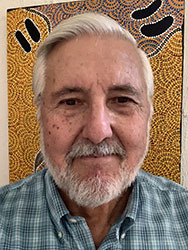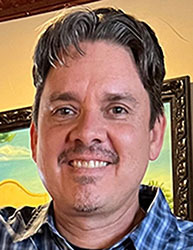You are here
Sage College DEI - Authors Action Research

Author Spotlight*
Learn why Ernest T. Stringer and Alfredo Ortiz Aragón wrote Action Research, Fifth Edition.
What inspired you to become a textbook author?
Ernest T. Stringer: I was inspired to become a textbook author to share my experience working with Aboriginal peoples. As a young man employed as a teacher at a remote Aboriginal community, where they lived according to their traditional hunter–gatherer lifestyle, I was expected to teach a curriculum and methods of instruction designed for the mainstream Australian population. The disparity between what was needed and what was given became evident, even to my inexperienced eyes, and I spent much of the following decade re-educating myself to discover solutions to a problem that was not even seen or acknowledged by the state education system. Though my studies failed to equip me, I gained a deeper understanding of the dynamics of political, social, and cultural systems that held these inappropriate education practices in place.
A breakthrough came to me nearly ten years into my career as a university lecturer/professor, when two Aboriginal men, Trevor Satour and Darryl Kickett, asked me to assist them to start a Centre for Aboriginal Studies at my university. At that time, the university had no Aboriginal employees of any kind and only graduated about one Aboriginal person every three years. In collaboration with others, we began to develop the foundational elements of that Centre, focusing at all times on the history and experiences of Aboriginal peoples and their social, cultural, and educational needs. We were able to employ Aboriginal people who had a long history working in services and programs for their communities; they were chosen for their extensive experience and deeply respected relationships with Aboriginal families and social groups. The partnership proved hugely successful. Within a few years, the Centre was providing programs and courses that drew Aboriginal students from across Australia, and a recent history provides exciting narratives of the transformational impact on both instructors and students.
Alfredo Ortiz Aragón: I had been thinking about publishing a book for a while, had two or three ideas and outlines for books, and even had a certain level of development for each one. I enjoyed writing and had published many articles and book chapters about action research (AR).
Ernie [Ernest Stringer] approached me at the International Congress for Qualitative Inquiry (ICQI), where I had met him the previous year through Mary Brydon-Miller, an AR friend in common. The three of us were having dinner one night, and in the middle of the dinner, I suddenly had this feeling that I was being interviewed, as Ernie was asking me a lot of questions about who I was, my background, my philosophy, etc. When he was done, he let me know that he needed a co-author—a writing partner—considering he was not as young as he was before. He asked me very directly, “Would you be my coauthor”? And, so, I did. It was a lot of work, but we worked well together, and he was very open to different ideas, even though this was his book alone for four previous editions.
We aim to amplify diverse voices and represent diverse identities in our content. How does this come through in your writing?
Alfredo Ortiz Aragón: We do a lot in our lit corner to bring in examples from all around the world—including from Indigenous groups, youth, and different ethnicities—to help amplify their often-marginalized voices. For example, we include stories from research that shows how AR helps children in South Korea influence the design of their own play area, another experience that encourages action researchers to reflect on whether they are enabling diverse voices to be heard and lead, and another that elevates Indigenous knowledge and critically questions the validity of dominant ways of conducting research.
I have brought in some examples from working in South America and other parts of the world into the writing, as well. Ernie’s whole career was built on working directly with Aboriginal groups in Australia. So that comes out in many of the examples. We were also sure to ask such questions as “Whose knowledge counts?” and examine the idea of participation. If you look at our model in Chapter 1, we lay out three ideas:
- taking action for purposes of learning;
- learning from that action—reflecting, documenting, and deciding upon future actions; and
- participation of those who know, where we explain in good detail what it means to work with the diverse knowledge of the people that we're trying to help. This includes knowing that their participation will fundamentally change the direction of an action research process to better reflect their needs.
What unique perspective or lived experience do you bring to your book that helps students relate to your content?
Ernest T. Stringer: All these experiences were personally transformational. I had limited understanding of the reality of people’s lives, but I had skills and knowledge that enabled me to work with local cultural “experts” to make a real difference in people’s lives. Taking my newfound expertise to a large Texas university, I applied different approaches to teaching, learning, and research to postgraduate classes and discovered they worked amazingly well, the students sometimes rhapsodic about their learning experiences. Since then, I have found that some simple principles and practices, now embodied in texts I produce, can be applied to a diversity of locations, from elite mainstream school and university settings, through education systems in developing nations, to social systems in remote desert communities.
In all this, I approach any new situation as a novice, knowing that I have much to learn from the people with whom I work, a perspective that has given me much joy even in recent years as I approach retirement. Engaging a younger professor, Alfredo Ortiz Aragón, to join as coauthor on my Action Research text, proved, yet again, to be a very rewarding experience as I not only was able to share my experience, but also learn so much from him about issues like IT, social media, and participatory process.
Alfredo Ortiz Aragón: I was a practitioner for many years and came into academia much later in life. I bring in a practical approach around “How do you make this usable for people in their everyday lives?” The 4th edition already did that, but I helped take that a little bit further.
I also bring a critical sensibility of diversity and my experience as a Hispanic growing up in northern New Mexico (not withstanding a lot of problems that exist between Hispanics and Native Americans, which is another story that needs to be addressed). I have come to understand that my story—even though we have been in the NM region for over 400 years—is really not well-reflected in the American narrative, in the telling of what it means to be an American. I don't think it's right, and I know it doesn’t feel good to be excluded—not just excluded in terms of story, but also in terms of language and culture. The United States—through formal and informal processes, many of which were educational!—has engaged in a huge culture-killing project for many years to eradicate Native American and Hispanic languages in New Mexico.
So, I continually bring up the idea that dominant ways of knowing that do not include our voices and experiences are not okay because they don't allow a multitude of perspectives to really have their place at the table. They exclude, they don't honor us at a basic level of humanity. I believe that equity means that everyone can tell our stories and celebrate our diversity while also finding humanity in our commonalities. But real DEI does not assume that the commonalities extinguish our uniqueness. I always try to elevate our uniqueness and diversity in my writing and explain how we need to use them as important ways of connecting to each other in research and other processes.
I also bring a very critical eye and critical questions about whose knowledge counts into the critical tone of the book—although it's very practitioner friendly. We also take a particular stand (led by Ernie) on the importance of universities really assuming their role in leading DEI conversations and helping us talk about what's really going on and how everyone can be included.
Our developmental approach really cares about the student and recognizes the diversity that they're working with. I think people read our book and can see that we really care about who they are. And we do take a stand for social justice and for inclusion, and for the diversity and equity that we and others bring to the table. Even our choice of cover was to opt for a picture of a group of youth from minority backgrounds conversing—showing that their knowledge counts.
How would you like to see your field advance conversations around Diversity, Equity, and Inclusion? In what areas is more research needed?
Ernest T. Stringer: There is a great need to engage approaches to research that provide practical, real-life solutions to problems deeply ingrained in people’s life worlds. This may require substantial changes to conventional images of what is “rigorous” research, the outcomes of which are usually published in professional and academic journals and reports meant only for an academic elite. There is a desperate need for researchers to communicate the outcomes of research in different ways, so that the people themselves have access to the knowledge emerging from research processes. The need for a communitarian approach to investigation has never been greater than in this era of “fake news,” with the concurrent need for approaches to dissemination that reach all the people. I stand by my original dictum that a truly community-based approach to research might be defined as the search for understanding in the company of friends
Alfredo Ortiz Aragón: I think conversation is the main idea. A problem that institutions have is that once they get the fever for talking about diversity, equity, and inclusion, it doesn't take long before they try to put them into their current structures, so they can say that they dealt with or addressed the issue. They may do this by hiring one person to be the DEI officer, or by creating cultural competency indicators that professors can then include in their classes, so that they can certify their classes are culturally competent.
I'm not saying those things aren't important. I'm just saying that it's the storytelling, the constant conversations about who we are, how we are similar and different in our backgrounds, that validates who we are and reveals critical unaddressed traumas and injustices. By continually generating processes whereby we tell and act on those stories, we will demystify and challenge the American meritocracy myth and the idea that this country has been built for the equitable benefit of all of its citizens and inhabitants. Using action research to have the conversations (acting, to learn), process what comes out of those conversations (learning to act), and take action from what we learn (acting, to learn again) is how we can foster change.
I was teaching in California a few years ago and some students said, “Hey, Ortiz, we're just back from a trip to Peru, and we want to meet with you”. I didn't know these 12-15 students that well—most of them were Mexican American, there was a Korean American, and there were a couple of Americans from Central American origins. It was a little bit intimidating, because I wasn't sure why I was there.
They proceeded to tell me that during their trip, they had felt relegated to translation and lower-end work, while what they deemed the “Peace Corps types”—mostly Anglo kids who had gone into the Peace Corps before coming to college (which almost none of the Hispanics had done)—had done the “thinking” work. The “Peace Corps types” took charge of all the thinking jobs—survey making and collecting, and data analysis—and really controlled access, making them feel like second-class citizens. Now I don't know how it actually played out. But if this many people felt put-off by what happened, it was probably important.
I also realized why they had called me in—it was because I was “Ortiz.” They knew that I embraced my ethnicity, spoke Spanish, and they felt like they could speak to me, without even knowing me that well. From that moment forward I knew I could no longer just be generic Professor Ortiz, who had myself overcome a few things—I also needed to be Hispanic leader Ortiz, and to include the voices of people in my community who are still not well-represented, suffer different types of microaggressions, and expect me to be a Hispanic leader when they need it.
Fast forward: What happened in Peru led to a series of critical yet healthy on campus conversations about race, privilege, and ethnicity. But just as things were really heating up and there was a buzz on campus, the university decided to create cultural competency indicators for classes as a way of codifying gains. And before you knew it, within a year I would say, the important conversations on campus had died down. The microaggressions were back up, but we had new cultural competency classes!
A better way to address what happened would have been to continue the conversations and provide safe spaces for doing so. Diversity was leading to inequity and exclusion in a live case study of who we really are as people—but we were grappling with it live through important conversations that lead to new understandings. That ended through committees that created sanitized cultural competency indicators.
Action research is uniquely placed to play the role of facilitating ongoing conversations that occur through engagement and conflict, because of its participatory and creative methodological approaches that value storytelling, but also value seeing stories as sources of data, analyze them, and use that analysis to take future action—all the way through to policy changes at the university and beyond.
*Published 07/22. © 2022 Sage Publishing. All rights reserved. All other brand and product names are the property of their respective owners.


